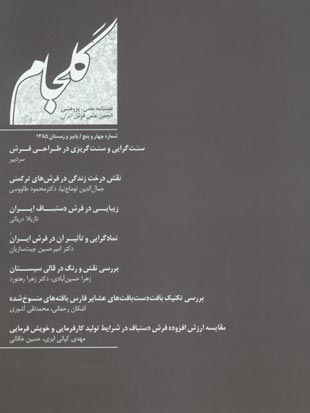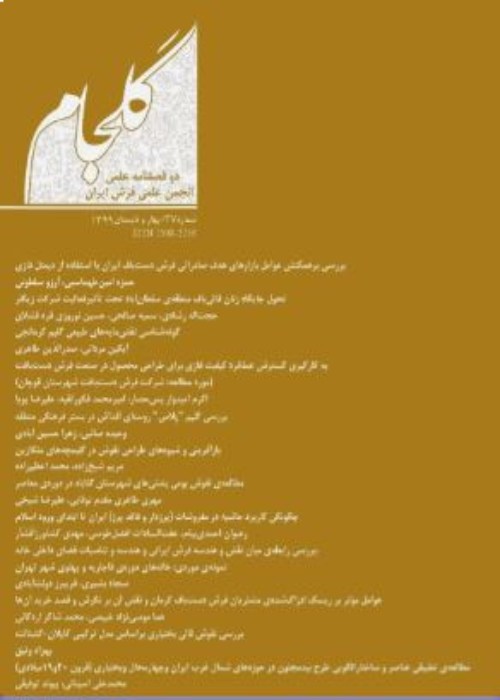فهرست مطالب

نشریه گلجام
پیاپی 4-5 (پاییز و زمستان 1385)
- 118 صفحه، بهای روی جلد: 20,000ريال
- تاریخ انتشار: 1385/08/20
- تعداد عناوین: 7
-
-
صفحه 11در اسلام درخت زندگی را سدره یا طوبی می خوانند. در اذهان پیروان دین اسلام این درخت در بهشت می روید، پس موضوعی است مناسب جهت خلاقیت های هنری در اصطلاح ترکمنی درخت زندگی را یاشایش باغ می خوانند. در این جستار سعی در بررسی نماد درخت و درخت زندگی است با رویکرد به اشکال درخت زندگی در تمدنهای باستانی و مقایسه این اشکال با نقوش موجود در فرشها و دستبافته های ترکمنی، برای بررسی...
کلیدواژگان: درخت زندگی، درخت، فرشهای ترکمنی، جانماز، انسی، نماز لیق -
صفحه 25زیبایی فرش ایرانی یکی از عواملی است که باعث ماندگاری آن در جهان هنر شده است. شناخت بنیان چنین زیبایی هایی، ارزیابی از فرش را هموار کرده و برای این ارزیابی، معیارهای مناسبی به دست می دهد. همچنین شناخت و به کارگیری عوامل تاثیرگذار بر مرغوبیت و زیبایی فرش ایرانی، به جاودانگی آن کمک خواهد کرد. از این رو لازم است مجموعه عناصر و عواملی را که باعث زیبایی فرش ایران می شود...
کلیدواژگان: فرش دستباف، زیبایی، زیبایی شناسی فرش -
صفحه 37زیبایی دوستی و نمادگرایی دو ویژگی اصیل انسانی است که از آغازین دوره های حیات او در اثار و بقایای هنرهایش نمودی خاص دارند. از جمله جایگاه های بروز و ظهور نمادها به ویژه در ایران فرش است. فرش چون آیینه عرش، بازتابی از نگاره ها و طرح و نقشهای نمادین با الهام از باورها، اندیشه ها و آرزوهای انسان فرش نشین است. در این پژوهش نمادگرایی در فرش ایران را به ویژه در عهد شکوفایی...
کلیدواژگان: فرش، زیبایی شناسی، نماد، نمادگرای، 0 طراحی فرش -
صفحه 57نقش و رنگ فرش سیستان متاثر از شرایط اقلیمی، فرهنگی، تاریخی و همچنین بافت تصویری منطقه است. هنرمندان و بافندگان این نقوش، با توجه به برداشتها، باورها، فرهنگ و قدمت تاریخی این دیار، نقشها و رنگهای خاصی را که حاوی مفاهیم آشکار و پنهان است، بر روی بافته های خود به کار می گیرند. در این تحقیق پس از بررسی نقوش و رنگهای به کار رفته در فرش این منطقه، به عواملی خواهیم پرداخت...
کلیدواژگان: فرش سیستان، رنگ، نقش، قالی -
صفحه 75در این تحقیق تکنیک بافت سه نمونه از دست بافت های کمیاب ایل قشقایی را بررسی کرده ایم. در دو نمونه اول به شباهت و تفاوت ساختار بافت هرکدام از آنها یعنی شیشه در مه بافی و ایی بافی اشاره کرده ایم.تشابه این دو بدین گونه است که هر دو دست بافته ای است داری، تخت باف از نوع پودکشی، و تارنما که در چله کشی آنها از دو رنگ متضاد استفاده می شود. و تفاوت آنها در این است که شیشه در...
کلیدواژگان: شیشه درمه بافی، ایی بافی، وارونه چین بافی، دولایه بافی، دوره چین بافی -
صفحه 87فرش دستباف از عمده اقلام صادراتی غیر نفتی کشور بودن که اشتغال وسیعی ایجاد کرده و ارتزاق حدود هشت الی نه میلیون نفر را به طور مستقیم یا غیر مستقیم تحت پوشش قرار می دهد. صادرات فرش دستباف ایران در سالهای اخیر سیر نزولی داشته است. این مسیر نزولی تهدیدی جدی برای بیکاری جمعیت کثیری از هموطنان است. یکی از دلایل مهم این امر، کاهش ارزش افزوده فرش...
کلیدواژگان: فرش دستباف، ارزش افزوده، خویش فرمایی، کارفرمایی
-
Page 11In Islam the “Tree of Life” is named as Sedreh or Tuba and the followers of Islam believe that this tree is grown in Heaven; therefore it is an interesting subject for artistic innovative. In Turkmen terminology “tree of life” is called “Yashaish bagh”. In this study we have made an effort to evaluate the symbol of the Tree and the “Tree of Life”, with reference to the shapes of the “Tree of Life” in the ancient civilizations and compare this shapes with the patterns present in the Turkmen rugs and hand – woven pieces; and to study the hypothesis that the name “Tree of Life” could be assigned to these patterns. The carried out comparisons show that Tree and “Tree of Life” designs in Turkment carpets patterns are similar to Islamic and ancient patterns.Keywords: “Tree of Life”, Tree, Turkmen rugs, Prayer Rugs, Ensi, Namazlik
-
Page 25Aesthetics of Iranian Hand Woven Carpets is one of the main reasons for its eternality. Recognition of such beauties, give one such scales for his/her evaluation about this matter. These elements are qualified features which affect on aesthetics of Iranian carpets and help to its eternality. This survey takes into consideration the main cases according to their relations toward carpet aesthetics. The main aim of this study is classifying, determining and introducing the reasons of carpet aesthetics and also the relations of these factors with cultural, artistic values of the society. To know if the Iranian Hand Woven carpets have aesthetics values or not and also if it has, determining such categories, are the main questions of this survey. In conclusion we understand that Iranian carpets have aesthetics features which I classified in two categories, one is intrinsic characteristics and the other is extrinsic. Also extrinsic category is divided in two fields and design, color and size are three factors among them.Keywords: Iran Hand woven Carpet, Aesthetics, Aesthetics principles of Iranian Hand woven Carpets
-
Page 37Symbolism and love of beauty are two fundamental particulars of human kind having special effects on his works of art. Carpet, particularly in Iran, has been one of the grounds of manifestation of symbols and carpet patterns represent symbolic designs. This study is an effort to study this issue, especially in the Safavid and Ghajrid eras which are considered to be the flourishing age of Iranian carpet. Written references as well as 80 pictures of carpets of that period of time constitute the main resources of this study and confirm our hypothesis of great effect of symbolism on Iranian carpet designing. In this study, I have introduced the theoretical grounds of carpet patterns symbolism and for the first time a classification is drawn up which may be used as a starting point for other studies.Keywords: Carpet artifact, Aesthetic, Symbol, Symbolism, Carpet Design
-
Page 57The pattern and the colour used in Sistan carpets is influenced by the climatic, cultural, historical, and image-weaving conditions of the region. In view of their conception, beliefs, culture and the historical antiquity of the region, the artists and weavers of such images choose peculiar patterns and colours bearing their overt and covert understanding that are depicted in their weaving works. This research after studying the patterns and colours used in them, takes into account those factors whose appearance has been truly effective in their formation and style. These pictorial phenomena that associate their rank and status with the degree of demand and selection of the masses enjoy varied meanings and concepts and the effect of the natural inspiration in them attains, at times, such an abstraction that their place in the surrounding phenomena could hardly be recognized. Visual qualities and values in the colour and the pattern of Sistan carpet are varied and extensive. One most significant of them is the value of in unity multiplicity portrayed in the Sistan carpet more prominently in two elements of color and pattern. Keeping in view the past history and the epic of the people of Sistan and the mode of beliefs and mores prevailing over the region, similarly the peculiar temperament of the land, the patterns and colours used in the hand-woven and other artifacts are a sort of symbolism and an association of events and incidents that are in fact a linkage between self-conscious rational world and the instinctive world; the weavers of this style resort to patterns and colors in order to express natural elements and their own ideals.Keywords: Sistan Carpet, Color, Pattern
-
Page 75This study examines weaving techniques in three rare samples of Ghashghaei tribe hand-woven artifacts. Two first samples, “Shishe dermeh baafi” and “O’ei baafi” (2 laaye baafi) we found similarities and differences in the weaving structures, which are: Similarities: Both are hand-woven products woven through flat weaving, having two opposite colours warp and woof. Differences: “Shishe dermeh baafi” is one layered while “O’ei baafi” is a two layered woven object. In warp and woof structure of “Shishe dermeh baafi”, the face side strings are evenly dark and the opposite side strings are bright, while in “O’ei baafi” the strings are dark and bright alternately. “Vaarune chin baafi” is the third type of weaving which was examined. This type of weaving is similar to “Rond baffi” (Verni Baafi) but the patterns are much more.Keywords: Shishe dermeh baafi, Oei baafi (2 laaye baffi), Vaarune chin baafi, Doreh chin baffi, Ghashghaei tribe
-
Page 87Hand made rug is one of the major non-petroleum exported items which directly and indirectly supports the employment of large number of people around 8 to 9 millions in the recent years.The exportation of hand-made carpet has descended and it is considered a serious threat and may end to unemployment for a large number of the countrymen. This is one of the important reasons for the extra decrease of the carpet value. In this regard, the ordinary carpet in Hamedan and Fars and tiny weaved carpet in Isfahan have been investigated. The carpet under the investigation in Hamedan province is of rural woven type, in Fars province is Kashkooli woven type and in Isfahan’s is 34-meter type. The selection of these carpets is according to the experienced expert and the frequency of that type of carpet in the mentioned provinces. The data collection was performed through the questionnaire. The number of samples for each province was assigned at the level of 40”. Then the samples were randomly selected. After the data collection related to production expenditures, the expenditures divided into direct and indirect ones. The direct expenditures consisted of elementary materials and direct wages, and indirect expenditures consisted of electricity, water, rental, and asset. When the expenditure means were assigned, the carpet sale price was computed too. Then the additional value was investigated on the two conditions of self-employment and management. Also, the type of production management was assigned based on the additional value. The results indicated that the additional value on the condition of self-employment and management in Hamedan province for rural carpet is equal to 37726 and 140707 and in Isfahan province for 34 meter type is equal to 82050 and, 161508, and in Fars province for tribal Kashkooli for each meter is equal to 4177 and 28138.Keywords: additional value, self-employment, management, the finished expenditur Teach Ardestan, Instructor of department accounting Ilam university


